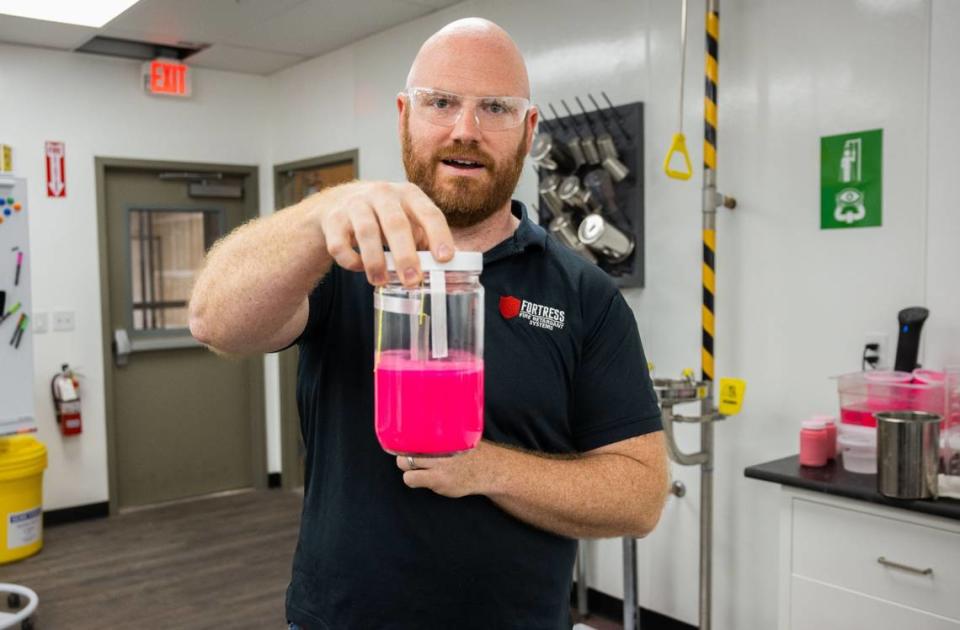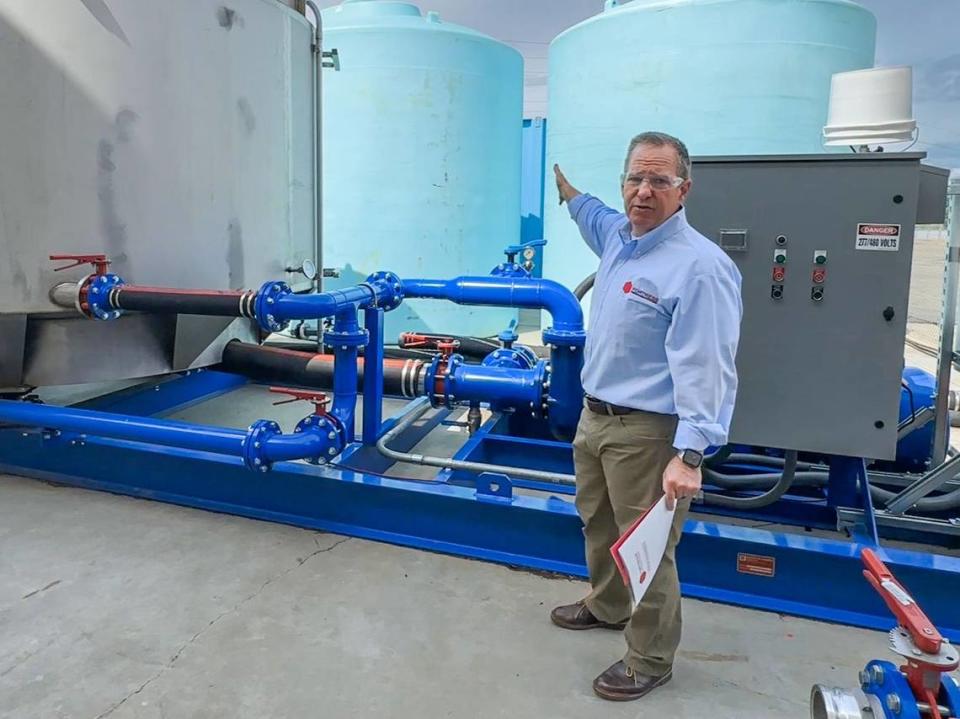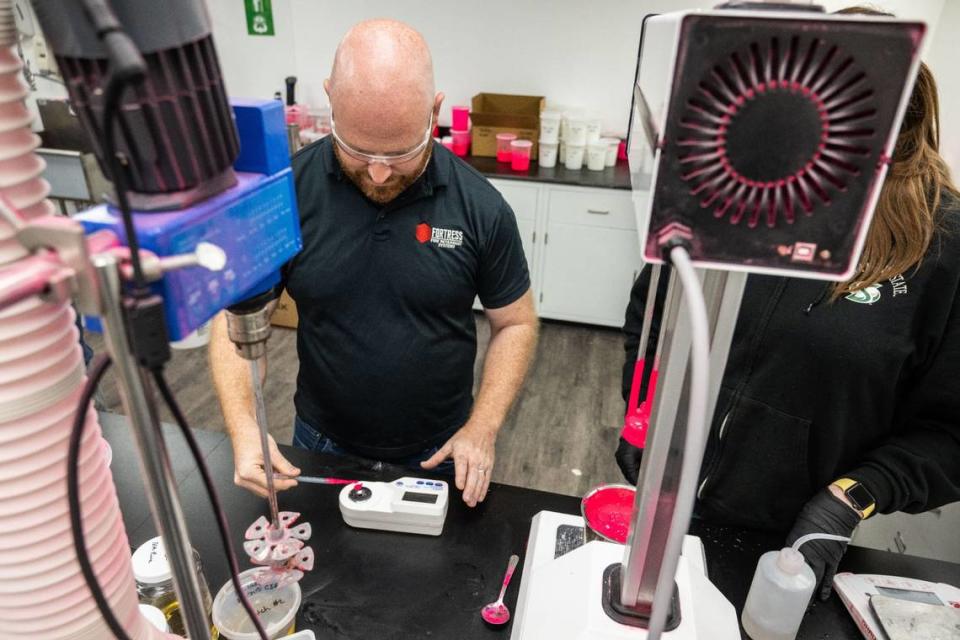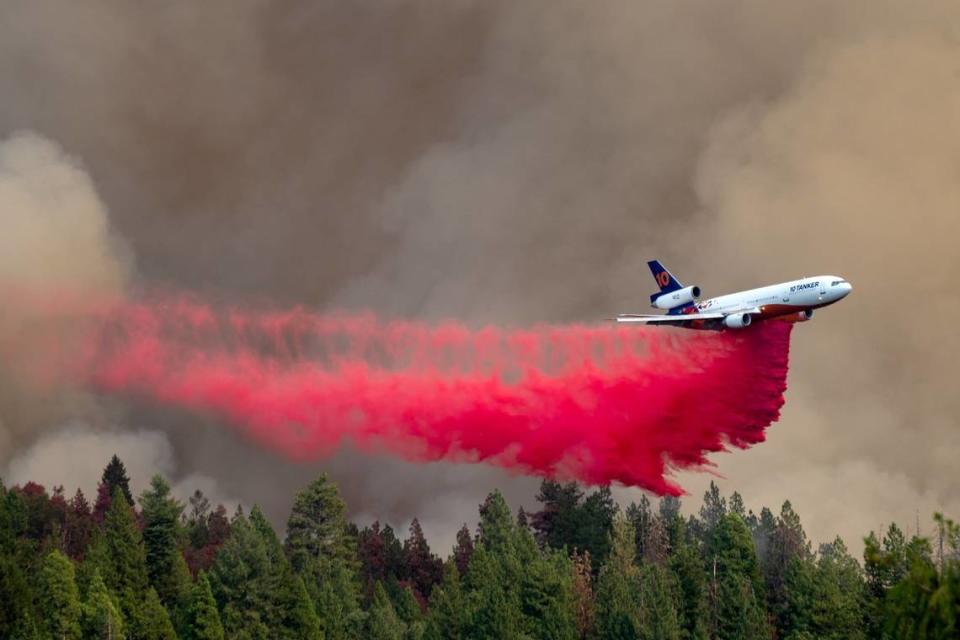How this Rocklin company shattered the monopoly on fire retardant to help fight wildfires
Dennis Hulbert used to set hundreds of fires in his backyard in Grass Valley.
He wasn’t trying to burn his his house down. Hubert, 70, is a retired fire-fighting leader of the U.S. Forest Service in California and was obsessed with finding the right chemicals to extinguish his controlled fires. He now finds his obsession may pay off.
He discovered magnesium chloride, a natural salt product, effectively extinguished the blazes. A plus, the chemical was readily available domestically from the Great Salt Lake in Utah or San Francisco Bay.
He and former aerial fire leaders in the Forest Service and the Bureau of Land Management believed they had found the essence of a new business, supplying the next generation fire retardant to drop from airplanes to douse wildfires.
The former fires leaders formed their company, Fortress Fire Retardant Systems, in Rocklin in 2017. A chemist was hired to refine the firefighting formula. The plan was to break up the nearly two-decade monopoly held by Perimeter Solutions of St. Louis on the sale of aerial fire retardant.
Fortress officials continued to tinker with their formula, submitting it to the Forest Service, the world’s largest user of aerial fire retardant, for testing in 2018. It took six years, and countless product refinements, but now they have a contract with the federal agency, turning Hulbert’s original backyard work into a potential huge payday.

On May 3, Fortress received a contract to supply the Forest Service with its aerial wildfire retardant beginning this fire season.
“We knew there was room for a second company to sell aerial fire retardant,” said Hulbert. “We wanted to end the monopoly.”
The company was awarded more than a contract, it was awarded a future.
What the sale means
Just two days after receiving its contract, Fortress was acquired by Compass Minerals in Overland Park, Kansas, for $28 million and potential bonuses to Fortress officials. Compass had already purchased 44% of Fortress in late 2021 for $45 million.
The company happens to manufacture magnesium chloride, extracting it by solar evaporation from the Great Salt Lake. It is the same magnesium chloride that Fortress officials decided would be the key chemical in Fortress aerial fire retardant products.
The new deal includes bonuses for Fortress officials of 30 cents for each gallon of fire retardant sold over the next 10 years. The Fortress contract with the Forest Service calls for the sale of up to 3 million gallons of retardant this fire season, meaning a $900 000 bonus for Fortress officials.

Perimeter Solutions sold more than 50 million gallons of fire retardant in 2020 and 2021 each to the U.S. Forest Service, so Fortress officials could see millions of bonuses if they can wrest market share away from their competitor in future years.
Just one gallon of fire retardant starts at $2 and can sell for as much as $7.
Perimeter Solutions in 2022 sold $226 million worth of fire retardant, 54% of it from the Forest Service and the California Department of Forestry and Fire Protection, also known as Cal Fire, according to the company’s May 5 annual report.
Perimeter Solutions success has enriched the company. So much so, that in a $2 billion deal in late 2021, it became a subsidiary of EverArc Holdings Ltd., based in Luxembourg.
The fire retardant waiting game
Fortress officials knew Perimeter Solutions was a big success. They saw a lucrative market for their aerial fire retardant but also knew they were entering a waiting game.
Fortress Chief Executive Officer Robert Burnham said the Forest Service approval process moved slower than expected. He questioned whether the fire retardants would ever get to market.
“Fortress was a true startup,” said Burnham.
Now in his 70s, Burnham rose from firefighter to chief deputy director of fire and aviation management for the Bureau of Land Management in California before retiring more than 20 years ago.
Burnham said the small group of founders used their money to get the company off the ground.
“We were writing checks out of our retirement accounts explaining to our wives what a good deal this would be,” he recalled. “Don’t worry honey, it will be alright.”
Burnham said the group raised around $25 million. He said the acquisition by Compass Minerals will give the company the capital it needs to scale its business to compete aggressively with Perimeter Solutions.
Not only has Perimeter Solutions been an exclusive supplier to the Forest Service, it also operates firefighter air bases for the federal agency. The company also supplies Cal Fire.
Burnham has a big vision for Fortress. Fortress has 27 employees at its Rocklin office, which includes a testing lab, a distribution facility and a small manufacturing operation. The company has received $2.4 million in state tax credits with the stipulation it will grow to 60 employees by 2025.

Manufacturing of fire retardants are done mainly in Ogden, Utah. The company also has a small corporate office in Stephensville, Mont., at Burnham’s ranch.
“If you ask me what our ambition is, it’s to have 50% of the fire retardant market,” he said.
The company’s plans include not only supplying retardant, but competing with Perimeter Solutions to operate some of the more than 70 bases the Forest Service uses to fight wildfires.
Burnham also wants to supply Cal Fire, but he will have to wait. Perimeter Solutions’ contract with Cal Fireruns to mid-2024.
Fires and profits
Even though Fortress is only starting to sell the Forest Service fire retardant, Compass Minerals said the company is expected to generate between $20 and $25 million of revenue this year and profits in the low double-digit millions.
Fortress will have to be patient in its plan to go head-to-head with Perimeter Solutions.
In a March 6 letter stating the Forest Service intends to award a contract to Fortress, agency chief Randy Moore said Fortress will have one dedicated aircraft to fill up to 3 million gallons of its retardant this fire season.
The Forest Service is deploying 24 aircraft to dump fire retardant this year, Burnham said. The other 23 aircraft would carry Perimeter Solutions fire retardants.
Burnham said Forest Service officials told him Fortress will be given the opportunity to compete with Perimeter Solutions to deploy aerial fire retardant in 3 years.
The Forest Service said in a statement that adding Fortress products complies with President Joe Biden’s executive order in July 2021 promoting competition in the American economy.
“Having two fire retardant sources not only increases completion in the sector, but also increases the stability of supplies to ensure the nation can respond to wildfires appropriately,” it said.
Perimeter Solutions fights back
Perimeter Solutions doesn’t plan to give up its lucrative business without a fight.
The company said its products are highly effective in fighting wildfires. The retardants use ammonium phosphate, an ingredient that can also be found in agricultural fertilizer.
“Experience matters, we’ve been doing this for 60 years,” said Eddie Goldberg, Perimeter Solutions vice-chairman.
The company has also developed an attack website, slamming the effectiveness of the Fortress fire retardant while touting its formula as the most effective.
It cites studies from the 1940s to the 1970s questioning the effectiveness of magnesium chloride in fighting fires.
Burnham said the studies on the effectiveness of magnesium chloride are outdated, the most recent one dating back 50 years.
He said Forest Service tests showed that Fortress performed 20% to 30% better than ammonium phosphate products used by Perimeter Solutions.
Both Fortress and Perimeter Solutions have also clashed on which line of fire retardants is more environmentally friendly.
Fortress contends that its products emit less in greenhouse gasses and won’t kill fish if they land accidentally in waterways, as opposed to the fatal consequences for marine life from the Perimeter Solution fire retardants.
Perimeter Solutions officials counter that Fortress fire retardants can be harmful to fish. They maintain their products are both safe and don’t harm the environment. Moore said Fortress will be evaluated after the 2023 season.
Lawsuit an issue
The Fortress contract comes as a lawsuit in federal court in Montana could curb the government’s use of aerial fire retardant. Forest Service Employees for Environmental Ethics, an advocacy group made up of current and former forest service employees, is suing the Forest Service, arguing that waterways are being polluted by fire retardants.
The group seeks injunction blocking the Forest Service from using aerial fire retardants until the agency gets a permit from the federal environmental officials.

The Forest Service has applied for the permit, but it could take several years to be granted.
In court filings, Forest Service officials have acknowledged that retardants have been dropped into waterways, mostly inadvertently, about 200 times in the past decade. They said the occurrence is usually by mistake, but occurs in less than 1% of the thousands of annual fire retardant drops.
“The only way to prevent accidental discharges of retardant to waters is to prohibit its use entirely,” government attorneys wrote. “Such a prohibition would be tantamount to a complete ban of aerial discharges of retardants.”
That would be fine for Andy Stahl, executive director of the advocacy group.
He believes that aerial fire retardant won’t work when the wind is blowing.
“Wind is the driver of every catastrophic fire in California history,” he said. “Retardant is completely ineffective when the wind is blowing. Wind blows embers up to a mile.”
Neither Fortress nor Perimeter Solutions is named in the suit.
The Forest Service has argued the deployment of aerial fire retardant saves lives and property.
Burnham isn’t worried that the lawsuit will stop the aerial spraying of fire retardant before his company gets its chance. He said that he doubts a judge based in conservative Montana would impose such a ban, given the destructive nature of wildfires.
Hulbert said the favorable outcome for Fortress was a group effort.
“We didn’t have any illusions of grandeur, he said. “It took a long time to get Forest Service approval for our fire retardants and there was always another step we had to take. I was shocked that we finally succeeded.”

